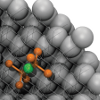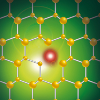Defects for quantum information processing
The idea of utilising quantum systems to perform complicated quantum mechanical simulations and calculations was raised by Richard Feynman [1] in 1982. This basic idea has initiated new directions in many disciplines and influenced different fields of nowadays physics. By now it has been widely accepted that quantum computation and information processing applications may possess extraordinary features and of great importance for future technologies.
The frontiers of physics science is actively working on the design of the building blocks, such as quantum bits (qubits), quantum gates, etc…, of quantum computer. One of the most promising candidate for the realisation of nano-scale blocks is the spin of a single point defect in a wide-band-gap semiconductor, which can be considered as a good compromise between other contenders and has a great techniqual advantages due to the large amount of accumulated experiences of semiconductor manufacture. The extraordinary properties of some special defect, such as the famous NV-centre in diamond, allow optical control of the electron and nuclear spin of an ensemble or a single point defect. Together with static and radio-wavelength electromagnetic field several quantum operations have been carried out with this systems so far.
Additionally, thanks to the achieved ultimate control, these point defects can be used to probe their environment realising nano-scale sensing tools. This recent direction of research and application is often called as nano-metrology.
Our group actively contributes to the development of these new fields by first principles and analytical characterisation of well established and promising point defects.
Nitrogen-vacancy center in diamond
Silicon-vacancy center in diamond
In a cooperation with partners in Russia and Germany, we have taken part in the work of predicting and validating the properties of silicon-vacancy colour centres in nanosized diamond particles. We have contributed with time-dependent DFT calculations, not carried out on such large systems so far. Nanoparticles for validating experiments have been extracted from a meteorite sample, but production of similar artificial nanoparticles seems to be very prospective in e.g. biosensing. This article has been selected for review in Nature News and Views.
Nature Nanotechnology 9, 54–58 (2014) DOI:10.1038/NNANO.2013.255
Silicon carbide defects
The extraordinary properties of NV-center in diamond exhibit great potential for the investigation of point defect based quantum information processing systems. However, from the application point of view the extreme hardness of diamond may cause difficulties in fabrication and can hinder the spreading of possible applications. Among the first, our group proposed the idea of considering silicon carbide (SiC) as a new target of research, which is a device friendly material but may host promising defects for quantum information processing. The idea of using SiC to host solid state quantum bits was first openly suggested by Adam Gali at International Conference of SiC and Related Materials 2009 (Nürnberg, Germany, 2009) reference where divacancy was the primary candidate where later other candidates were also theoretically studied references: Weber, Gali. The first breakthrough has been achieved for the coherent manipulation of ensemble divacancy and related defect spins in 4H polytype of SiC by the Awschalom group reference.
Investigation of new candidates in SiC is a rapidly developing direction of nowadays research. In this respect, the most actively studied defects in SiC are the divacancy references, the silicon vacancy references, and the carbon antisite-vacancy pair references.
In an international cooperation with Japanese and Australian colleagues, we supported the establishment and identification of the carbon antisite–vacancy pair as a world-record bright single-photon emitter in silicon carbide with theoretical work and computational simulation. The results have been highlighted in Nature Physics and Nature Photonics.
Nature Materials 13 151-156 (2014) DOI:10.1038/nmat3806

